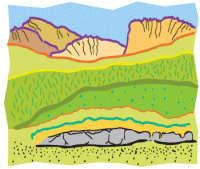

To send a message to an author, click on the author's name at the end of the article.
This Month in Ag Connection | Ag Connection - Other Issues Online
If you are in the business of farming - you need a business office. The home- business office can help make you a more effective and efficient business manager. Additionally, it will be a great tool in defending the deductibility of travel (commuting) costs between your home and the farm, if you do not live on the farm property.
You can qualify a room in your home as a farm business office if it is used exclusively and regularly as the principal place of business. Code Section 280A provides that a home office qualifies as the principal place of business if:

The IRS and Treasury Department recognized the difficulty and complexity of calculating, allocating, and substantiating the allowable deductions attributable to the home-business office and have now provided a safe-harbor deduction available for tax years beginning in 2013.
While the news of this provision was just released (January 13th), the basics of this safe-harbor provision are as follows:
Work with your tax consultant to insure all the "i's" are dotted and the "t's" are crossed in meeting the deductible requirements of your home-business office.
For more detailed information on this safe-harbor provision - see Revenue Procedure 2013-13.
Source: Parman R. Green, CPA, MU Extension Ag Business Mgmt. Specialist
This Month in Ag Connection | Ag Connection - Other Issues Online
A calving clinic for women was held at Missouri Valley Commission Company in Boonville with over 92 women, kids, and yes some very brave men. Dr. Dawna Voelkl, DVM Dipl ACT and Dr. Pamela Fry, DVM presented talks covering parturition and post-partum care. Following the talks, two phantom uteri were set up and participants were able to get hands on experience pulling different positioned calves. Here are some highlights about handling calving issues.

Labor can be divided into three stages. Stage I consists of dilation of the cervix, calf rotation into the upright position, and the beginning of uterine contractions. Heifers and cows may be nervous, kick at their side, and may exhibit slight straining. This is often observed in heifers, but may or may not be seen in cows. This stage usually lasts 2 to 6 hours, depending on the animal.
During Stage II, the calf enters the birth canal with the feet and head protruding first. Cows will probably be lying down. The water sac or calf becomes visible and there is a discharge of fluids. Calf delivery is complete at the end of this stage. This stage may last from 2 to 6 hours.
Stage III consists of uterine contractions to expel the fetal membranes. If the membranes aren't expelled within 12 hours, the cow or heifer will need attention.
It is important to recognize what is abnormal. They suggested that during Stage II, the time from feet being visible to birth should be no longer than 2 hours. If no progress is observed in 30 minutes, check to see if assistance is needed.
When examining a potential problem delivery, he indicated the objectives should be to determine if the cervix is dilated, if the water sac has broken, if the calf is in the proper position, and if the calf can pass through the pelvis.
There are three possible outcomes from the examination. First, the producer cannot determine what the problem is. The second outcome is the producer knows the problem and solution but can't handle it. The third outcome is the producer knows the problem and solution but is unsuccessful in correcting the problem within 30 minutes. For any of these outcomes, stop and get professional help.
They stressed the importance of cleanliness and demonstrated equipment and supplies to have on hand to assist heifers and cows experiencing calving difficulties.
Submitted: Heather Smith, MU Extension Assistant Livestock Specialist
This Month in Ag Connection | Ag Connection - Other Issues Online
Even if the Midwest gets normal rain and snow, it will take almost two years for soil moisture deep in the earth to recharge and sustain normal crop growth, said a University of Missouri soil scientist.
Randall Miles, associate professor of soil science at the MU College of Agriculture, Food and Natural Resources, said that two years of drought in the Heartland have left many prime growing areas bone dry to at least five feet down. This is where the roots of the crops live, sucking up moisture and nutrients. Without enough water, these crops produce poor yields.
"Don't count a full recovery of soil moisture soon," Miles said. "Even if parts of the Midwest receive a lot of snowfall and rain, that moisture will take time to move deep into the soil where the driest conditions exist."
Miles said that roots have had to go down as deep as eight feet to extract water. Soil moisture recharge is a hydrologic process where water from rain and snow moves downward from surface water and fills in the pore space found in soil. The soil is recharged naturally by rain and snowmelt.
Hurricane helped a little - Parts of Missouri, Indiana and Illinois caught September rains from the remnants of Hurricane Isaac, which helped some of the recharging process there. Other areas, though, weren't as fortunate. The most recent U.S. Drought Monitor shows a stage 4 (most severe on the rating scale) drought in the central Great Plains of South Dakota, Nebraska, Kansas and Oklahoma, with neighboring regions showing increased degrees of drought. Miles has been observing the depths of soil moisture around Missouri. Places where Hurricane Isaac dropped extra rainfall are wet down to a few inches, but the ground is still dry below that level.
Miles pointed out that moisture near the surface can evaporate with just a few days of high winds, higher-than-normal temperatures or low relative humidity. This can prevent moisture from having a chance to move deep into the soil where it is needed. "The rain and snow will have to come almost continuously - an almost London type of weather pattern - if the soil is to be recharged soon," Miles said. "It will have to come down slow and steady to minimize runoff."
Microbial health and river depth a problem too - It could take two years of good rains for beneficial microbes and insects to recover as well, Miles said. "The soil lives in a balance of water and biological activity," Miles pointed out. "The deep drought has disrupted that biological activity."

The dry soil has impacted the Midwest's corn crop. Without the drought's influence, the USDA's trend line called for an average yield of 162 bushels of corn per acre. In 2012, that yield was only 122 bushels per acre. There have been four years of below-trend-line production in many areas. Many Midwestern ranchers have culled their herds because there isn't enough feed forage or water from ponds and streams that have dried up.
Miles said that a lack of moisture passing through the soil and into waterways could also affect barge traffic on the Mississippi and Missouri rivers. Those river levels could be down for another two or more years, too.
Story source: Randall Miles, MU Associate Professor of soil science
This Month in Ag Connection | Ag Connection - Other Issues Online
In 2002, The Environmental Protection Agency (EPA) established the Spill Prevention, Control, and Countermeasure (SPCC) final rule. Since then it has undergone various amendments and now a final date of May 10, 2013 for compliance when these plans need to be in place. The website from EPA for determining if you qualify and what you need to include in the plan is located at: http://www.edp.gov/emergencies/content/spcc/index.htm . If you have one or more tanks that contain at least 1,320 gallons, then you qualify to need a SPCC plan.
Bob Broz, Extension Assistant Professor in water quality, has reviewed the EPA material and has summarized what is needed.
You must have a SPCC plan if you:
What information is needed to prepare an SPCC Plan?
What spill prevention measures should be implemented and included in the SPCC plan

There are two different regulations at play in this scenario. The first is the SPCC rule that requires attention by May 10, 2013, but the underlying regulation is the secondary containment regulations (from 1973). The SPCC regulations ask what you plant to do to prevent a spill or contain it. It doesn't state that you must have secondary containment-that falls under the other regulation that says if you have one tank over 660 gallons or a series of tanks over 1320 gallons then you must have secondary containment.
If your storage qualifies under the rules for a SPCC plan, you need to fill out the template forms from the EPA website and have a plan of action on what to do if there is a spill. You should keep a copy of this in your records, close to the fuel tanks, and maybe one with the local fire department so they can review it and check to make sure it is feasible.
Source: Wayne Crook, Agronomy Specialist
This Month in Ag Connection | Ag Connection - Other Issues Online
Publishing Information
Ag Connection is published monthly for Northeast and Central areas of Missouri producers and is supported by the University of Missouri Extension, the Missouri Agricultural Experiment Station, and the MU College of Agriculture, Food and Natural Resources. Managing Editor: Mary Sobba.